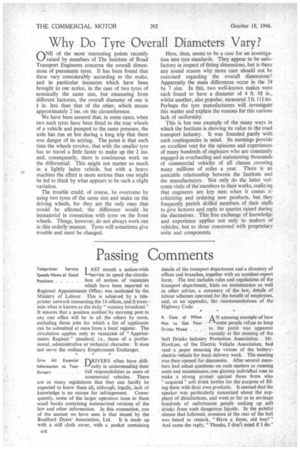Why Do Tyre Overall Diameters Vary?
Page 24

If you've noticed an error in this article please click here to report it so we can fix it.
(-NNE of the most interesting points recently raised by members of The Institute of Road Transport Engineers concerns the overall dimensions of pneumatic tyres. It has been found that these vary considerably according to the make, and in particular instances which have been brought to our notice, in the case of two tyres of nominally the same size, but emanating from different factories, the overall diameter of one is in. less than that of the other, which means approximately 2 ins, on the circumference.
We have been assured that, in some cases, when two such tyres have been fitted to the rear wheels of a vehicle and pumped to the same pressure, the axle has run so hot during a long trip that there was danger of its seizing. The point is that each time the wheels revolve, that with the smaller tyre has to travel a little faster to make up the 2 ins. and, consequently, there is continuous work on the differential. This might not matter so much in a lightly laden vehicle, but with a heavy machine the effect is more serious than one might be led to think by what appears to be such a slight variation.
The trouble could, of course, be overcome by using two tyres of the same size and make on the driving wheels, for they are the only ones that would be affected; the difference would be immaterial in connection with tyres on the front wheels. Things, however, do not always work out in this orderly manner. Tyres will sometimes give trouble and must be changed. Here, then, seems to be a case for an investigation into tyre standards. They appear to be &adsfactory in respect of fitting dimensions, but is there any sound reason why more care should not be exercised regarding the overall dimensions? Apparently the main differences occur in the 34 by 7 size. In this, two well-known makes were each found to have a diameter of 4 ft. Of in., whilst another, also popular, measured 3 ft. 111 ins. Perhaps the tyre manufacturers will investigate this matter and explain the reasons for this curious lack of uniformity. This is but one example of the many ways in which the Institute is showing its value to the road transport industry. It was founded partly with such contingencies in mind. Its meetings provide an excellent vent for the opinions and experiences of many hundreds of engineers who are constantly engaged in overhauling and maintaining thousands of commercial vehicles of all classes covering many millions of miles a year. There is an amicable relationship between the Institute and the manufacturers. Not only do the latter welcome visits of the'members to their works, realizing that engineers are key men when it comes to criticizing and ordering new products, but they frequently permit skilled members of their staffs to give lectures and reply to queries raised during the discussions. This free exchange of knowledge and experience applies not only to makers of vehicles, but to those concerned with proprietary units and components.












































































